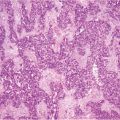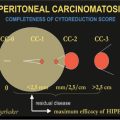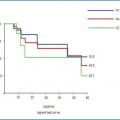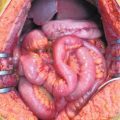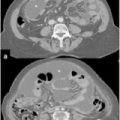Fig. 3.1
Cellular pathology of peritoneal invasion and colonization and molecular pathways
3.3.1 Loss of Cell Adhesion and Increased Motility
After detachment from the primary cancer, free tumor cells show reduced adhesion and increased motility to the peritoneum. In this phase, inactivation of cell—cell adhesion molecules (CAMs) plays a pivotal role in changing the cytoskeletal structure [6]. The CAM group comprises integrins, cadherins, selectins, and some members of the immunoglobulin family. Moreover, among the mitogen-activated protein kinase (MAPK) cascade, epidermal growth factor receptor (EGFR) and c-MET oncogenes are considered and important pathway in cancer cell spread [7].
3.3.2 Anoikis Resistance
Anoikis is the term that designates the response of nontumor cells to loss of cellmatrix contact due to specific apoptosis programming; metastatic cancer cells are unable to anoikis. This factor causes their survival after detachment from the primary tumor and their spread through vessels to other organs. Anoikis evasion is, in fact, the preliminary step and thus a targeted study for the diffusion of free cancer cells. Interestingly enough, anoikis restoration using targeted therapies is a novel approach in modern medicine, called personalized medicine, for treating patients affected by metastatic cancer [8].
Kallikrein-related peptidase (KLK) and V-Src sarcoma viral oncogene homolog (Src) are involved in the homeostasis of anoikis, and deregulation is responsible of PM.
3.3.3 Migration and Adhesion to the Peritoneum
In this phase, free cancer cells have an increased pathogenic motility. They adhere to the peritoneal surface, where they colonize and invade it. Pivotal molecules— integrin and cadherin proteins—guarantee adhesion between the extracellular matrix (ECM) and tumor cells.
3.3.4 Peritoneal Invasion
For peritoneal invasion, the disruption of ECM by proteolytic enzymes is necessary; cancer cells directly secrete these enzymes. Matrix metallopeptidase (MMP) is a protein involved in this process facilitating cancer cell invasion by ECM digestion [9]. At that stage, cancer cells are able to attach to the basement membrane.
3.3.5 Peritoneal Colonization
Free cancer cells need to survive after detachment from the primary tumor and so produce growth factors and receptors. Peritoneal colonization is associated with stimulation by cancer cells of tumor-associated stroma to produce several growth factors. This phenomenon is called homing; the homing of cancer cells to the peritoneum represents a multistep process that involves malignant progression of the primary tumor, tumor invasion through the ECM, and settling of tumor cells in the peritoneum. In the homing phase, insulin-like growth factor 1 (IGF-1) and vascular endothelial growth factor (VEGF) and their related receptors play a preponderant role [10].
Stay updated, free articles. Join our Telegram channel

Full access? Get Clinical Tree



